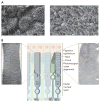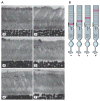Phagocytosis of retinal rod and cone photoreceptors
- PMID: 20134024
- PMCID: PMC2839896
- DOI: 10.1152/physiol.00038.2009
Phagocytosis of retinal rod and cone photoreceptors
Abstract
Photoreceptor cells maintain a roughly constant length by continuously generating new outer segments from their base while simultaneously releasing mature outer segments engulfed by the retinal pigment epithelium (RPE). Thus postmitotic RPE cells phagocytose an immense amount of material over a lifetime, disposing of photoreceptor cell waste while retaining useful content. This review focuses on current knowledge of outer segment phagocytosis, discussing the steps involved along with their critical participants as well as how various perturbations in outer segment (OS) disposal can lead to retinopathies.
Figures




References
-
- Anderson DH, Fisher SK. Disc shedding in rodlike and cone-like photoreceptors of tree squirrels. Science. 1975;187:953–955. - PubMed
-
- Anderson DH, Fisher SK, Steinberg RH. Mammalian cones: disc shedding, phagocytosis, renewal. Invest Ophthalmol Vis Sci. 1978;17:117–133. - PubMed
-
- Basinger S, Hoffman R, Matthes M. Photoreceptor shedding is initiated by light in the frog retina. Science. 1976;194:1074–1076. - PubMed
-
- Besharse JC, Hollyfield JG. Turnover of mouse photoreceptor outer segments in constant light and darkness. Invest Ophthalmol Vis Sci. 1979;18:1019–1024. - PubMed
Publication types
MeSH terms
Grants and funding
LinkOut - more resources
Full Text Sources
Other Literature Sources
Medical

